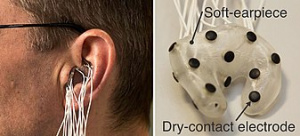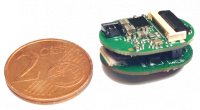Difference between revisions of "EEG earbud"
From iis-projects
| Line 57: | Line 57: | ||
[[Category:Human Intranet]] | [[Category:Human Intranet]] | ||
[[Category:SmartSensors]] | [[Category:SmartSensors]] | ||
| + | [[Category:WearablesHealth]] | ||
Latest revision as of 19:01, 6 December 2023
Contents
Short Description
Electroencephalography (EEG) is a method used to monitor brain activity by placing electrodes on the scalp to record electrical patterns in the brain. It's vital for studying brain function and has medical applications, such as diagnosing and treating epilepsy. However, traditional EEG systems are inconvenient for everyday use due to the complex setup, bulkiness, and stigma associated with wearing EEG caps.
A possible solution is EEG measurements with in-ear EEG earbuds [Kappel et al., 2019], offering a more user-friendly solution. It eliminates the need for external scalp electrodes, providing a more comfortable and unobtrusive experience. Users can easily wear and adjust the earbuds themselves, simplifying the setup process. The device is compact and lightweight, allowing for greater mobility during EEG recordings and enabling users to engage in normal activities without restrictions. To reach these goals, the project makes use of the BioGAP platform [Frey et al., 2023] and aims to integrate it into an earbud formfactor.
Goal & Tasks
The main tasks of this project are:
- Literature study of EEG, possible in-ear electrode positions
- Test different electrode types and positions
- Design and fabrication of an earbud integrating electrodes, as well as the acquisition electronics based on BioGAP
Prerequisites
- Python or Matlab basics
- Experimental design and testing skills
- Problem-solving and creativity
Literature
- S. Frey, M. Guermandi, S. Benatti, V. Kartsch, A. Cossettini and L. Benini, "BioGAP: a 10-Core FP-capable Ultra-Low Power IoT Processor, with Medical-Grade AFE and BLE Connectivity for Wearable Biosignal Processing," 2023 IEEE International Conference on Omni-layer Intelligent Systems (COINS), Berlin, Germany, 2023, pp. 1-7, doi: 10.1109/COINS57856.2023.10189286.
- Kappel SL, Makeig S, Kidmose P. Ear-EEG Forward Models: Improved Head-Models for Ear-EEG. Front Neurosci. 2019 Sep 10;13:943. doi: 10.3389/fnins.2019.00943. PMID: 31551697; PMCID: PMC6747017.
- https://hackaday.com/2023/10/17/open-source-ear-monitoring-platform-listens-to-your-ears/
Status: Available
- Looking for Semester, Bachelor, and Master Students, the project can also be implemented in a collaborative way between multiple Bachelor students
- Supervision: Sebastian Frey, Victor Kartsch, Andrea Cossettini, Simone Benatti
Character
- 15% Literature Study
- 30% System assembly design
- 25% Data processing
- 30% experiments and characterization

